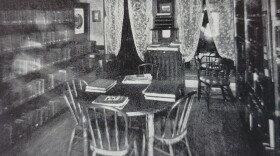July 4th, 1977, a Monday that year, started out hot and muggy. Northwood’s residents and visitors made their way out to the local beaches and parks for a day of picnics and the 4th of July festivities. Just after noon, the super-heated air became stagnant, the proverbial calm before the storm.
Sawyer County was the first to receive the blow around 1 pm. The storm moved east across the north central part of the state in a 17-mile-wide by 166-mil-long swath of devastation. Witnesses recall the sky turning pea green and bubble-like clouds forming just before the winds picked up.
In Rhinelander, city police were made aware of a quickly developing weather system moving into the area. Squad cars rushed to the parks where hundreds of people were warned of the approaching storm. Some folks tried to leave the park, others retreated to vehicles.
People throughout the Northwoods took shelter as best they could, from crouching in bathtubs, running into school basements, and even hiding under railroad freight cars to avoid the turbulence. The winds were like a jet engine, the sound of trees being uprooted, and limbs snapping could be heard, as dirt was tossed high into the air. Boats and docks on area lakes were picked up by the powerful force and strewn across the water.
Weather recording instruments at the Phillips, and Oneida County Airports registered winds over 100 miles per hour before the units were ripped away by the drafts around 3:30 pm. The high winds were accompanied by thunder, lightning, and heavy rains.
115+ mph downbursts flatted thousands of trees. In the Flambeau River State Forest, 4-foot diameter trees had been utterly destroyed. Over 500,000 acres of forest had been damaged across the storm area. Practically every road in Sawyer, Price, and Oneida Counties was virtually impassible due to debris. Resulting power outages lasted for over a week in some areas as crews worked night and day to cut through trees, restring lines, and replace poles.
Rhinelander’s Pioneer Park had lost half of its towering pines in the storm, now laying toppled like giant toothpicks spilled on the floor. Some would be replaced with new plantings, but the park has never been the same.
The town of Phillips had been hardest hit. 30 homes in Price County had been demolished, and almost every building in the area took some damage.
The storm produced no tornadoes, but a powerful straight-line wind system now known as a derecho. This type of storm is obvious after the fact by downed trees laying in one direction, and the size of the area impacted. Many will recall a similar system that moved through the Elcho area in 2019.
The Independence Day Storm of 1977 only lasted about 25 minutes once it hit, but would end with $24 million dollars in damage at the time. 35 injuries were reported, as well as the death of a 5-year-old girl when a tree fell on her family’s camper van at Connor Lake near Philips.
Of course, 4th of July fireworks displays had to be postponed but were held a week after the storm despite the continuing cleanup, including to huge crowd at Rhinelander’s Hodag Park.

In the aftermath, famous meteorologist and researcher at the University of Chicago, Tetsuya “Ted” Fujita, developer of the F-Scale used to measure tornadoes, visited the Northwoods to study the effects of the storm. In total, the July 4th storm of 1977 moved across parts of Minnesota, through Wisconsin, and across Lake Michigan for 800 miles, damaging over 1 million acres of forest, and leaving behind the destruction of one of the worst storms in Northwood’s memory
*Source: National Weather Service, Newspaper Articles July 1977









